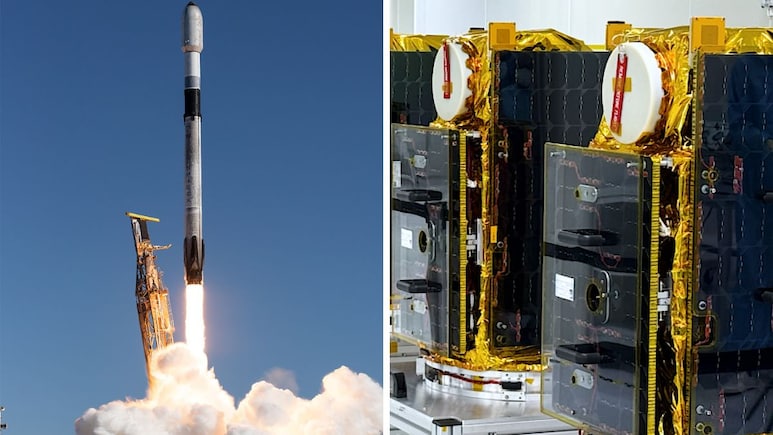
- Bengaluru-based Pixxel to launch three hyperspectral imaging satellites on Falcon 9 rocket
- This launch completes phase one of Pixxel's Fireflies six-satellite constellation
- Satellites weigh 50 kg each and capture images in 135+ spectral bands at 5m resolution
Bengaluru-based start-up Pixxel Space Technologies is set to launch three more advanced hyperspectral imaging satellites aboard SpaceX's Falcon 9 rocket from California. This launch will complete phase one of Pixxel's Fireflies constellation, marking a significant leap in Earth observation capabilities and positioning India as a global leader in commercial hyperspectral space imaging.
It may be recalled that India's astronaut, Group Captain Shubhanshu Shukla, also flew on a Falcon-9 rocket to space from the Kennedy Space Centre in Florida on June 25. India's connection with the Falcon-9 rocket endures a little more.
The satellites, dubbed "Fireflies," are compact, high-performance spacecraft weighing approximately 50 kilograms each. They are equipped with cutting-edge hyperspectral sensors capable of capturing imagery in more than 135 spectral bands at a resolution of five meters. This level of detail allows for unprecedented insights into environmental, agricultural, and industrial phenomena-ranging from detecting crop stress and pest infestations to identifying gas leaks and monitoring climate-driven changes across ecosystems.
Speaking exclusively to NDTV, Awais Ahmed, founder and CEO of Pixxel, shared his excitement and pride in the upcoming launch. "These are three more Fireflies, the same ones we launched earlier in January. The plan was to have six satellites in our constellation. Three are up, they are working, they are beaming down data. And three more are now going up on the SpaceX Falcon 9 rocket. So, that will complete our six-satellite constellation phase one," he said.
The Fireflies constellation is designed to operate in a Sun-synchronous Low Earth Orbit at an altitude of 550 kilometres. This configuration enables daily revisit capability, allowing Pixxel to monitor any location on Earth with remarkable frequency and precision.
"With six Fireflies in orbit, we can monitor the planet with a fidelity never before seen in commercial space," Awais Ahmed explained. "We are closer than ever to making hyperspectral intelligence accessible to all those working to solve humanity's toughest challenges."
Pixxel's hyperspectral imaging technology goes far beyond traditional satellite imagery. While conventional satellites capture data in a handful of spectral bands, Pixxel's Fireflies analyse light across over 135 bands, revealing details invisible to the naked eye. This capability is crucial for applications such as early detection of crop diseases, mineral exploration, pollution tracking, and disaster response.
"We will do five-meter resolution hyperspectral imaging in 150 bands on each satellite," Awais Ahmed elaborated. "They will be able to see things that are otherwise invisible, like crop diseases or pest infestations, gas leaks, mineral exploration, and many other use cases."
The upcoming launch is part of SpaceX's NAOS Falcon 9 mission, scheduled to lift off from Vandenberg Space Force Base in California, USA.
Reflecting on the journey, Awais Ahmed acknowledged the nerves and excitement that come with each launch. "Excited, very excited. A little bit nervous, not as nervous as in January because we have three satellites working-these are replicas. So, very eager to see how the constellation continues to grow from here."
Pixxel's achievement is particularly notable as it represents a "Made in India" success story with global impact. "Made in India for the world," Awais Ahmed declared proudly. The company's rapid progress underscores the growing capabilities of India's private space ecosystem and its potential to contribute meaningfully to global scientific and commercial efforts.
The Fireflies constellation is just the beginning. Pixxel's roadmap includes expanding the satellite network for even higher revisit rates, integrating on-board artificial intelligence for real-time data processing, and scaling its digital platforms to make hyperspectral intelligence universally accessible.
"This launch is where our vision begins operating at scale," Awais Ahmed said. "With every new satellite, Pixxel moves closer to a future where the health of our planet can be monitored continuously, with speed, precision, and actionable intelligence at a global scale."
Pixxel's success also reflects a broader shift in space technology, where start-ups are increasingly driving innovation and delivering solutions that were once the domain of large government agencies. By leveraging advanced sensors, agile development cycles, and strategic partnerships, companies like Pixxel are redefining what's possible in Earth observation and space-based analytics.
As the countdown begins for the Falcon 9 launch, the excitement is palpable-not just within Pixxel, but across India's scientific and entrepreneurial communities. The Fireflies are poised to illuminate the planet in ways never seen before, offering a glimpse into a future where space technology serves humanity's most pressing needs.
Track Latest News Live on NDTV.com and get news updates from India and around the world

